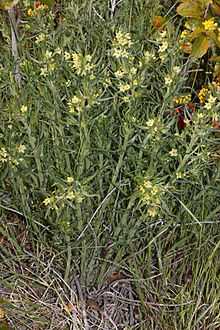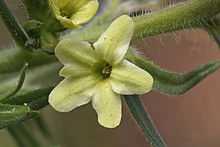Lithospermum ruderale
| Lithospermum ruderale | |
|---|---|
 | |
| Lithospermum ruderale in Wenas Wildlife Area, Washington | |
| Scientific classification | |
| Kingdom: | Plantae |
| (unranked): | Angiosperms |
| (unranked): | Eudicots |
| (unranked): | Asterids |
| Order: | (unplaced) |
| Family: | Boraginaceae |
| Subfamily: | Boraginoideae |
| Genus: | Lithospermum |
| Species: | L. ruderale |
| Binomial name | |
| Lithospermum ruderale Douglas ex Lehm. | |
Lithospermum ruderale is a species of flowering plant in the borage family known by the common name western stoneseed. It is native to western Canada and the western United States, where it can be found in many types of habitat. A perennial herb growing from a taproot and woody caudex, it is covered with fine, more or less upright, hairs, especially on the stems. It produces a cluster of erect leafy stems 20 to 50 centimeters tall. The stems support lance-shaped leaves up to 8 centimeters long. Bunches of flowers with leaf-like bracts appear toward the top of the stem amongst the leaves. The corolla is light yellow, often slightly greenish, and about a centimeter long and wide. The style is short. The fruit consists of one or two, sometimes four, clustered glossy grey nutlets, 3.5 to 6, sometimes as much as 8 mm long. This plant was used as a contraceptive by several Native American groups, including the Navajo and Shoshone.[1] Studies on mice showed the plant reduced their fertility.[2]

References
External links
 Media related to Lithospermum ruderale at Wikimedia Commons
Media related to Lithospermum ruderale at Wikimedia Commons- Jepson Manual Treatment
- USDA Plants Profile
- Photo gallery